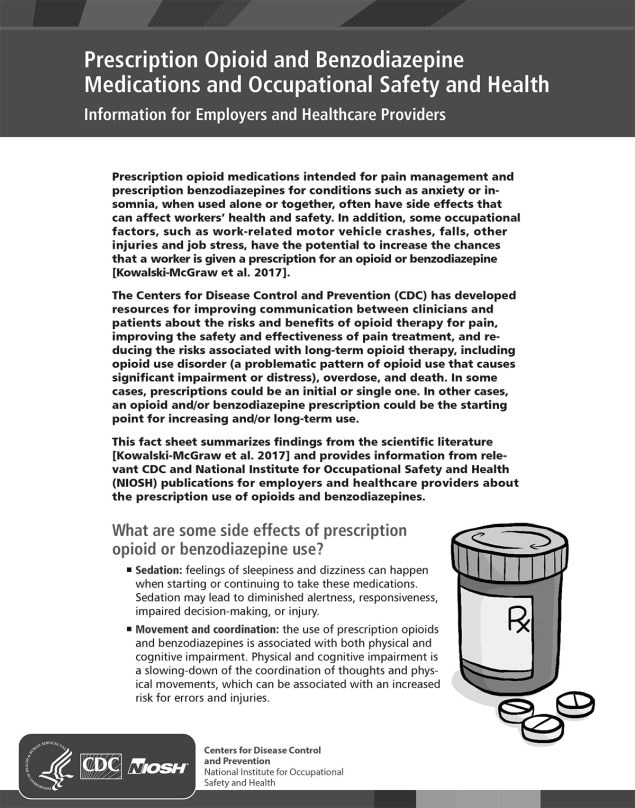About
This fact sheet provides information from relevant CDC and National Institute for Occupational Safety and Health publications for employers and healthcare providers about the prescription use of opioids and benzodiazepines. It also provides educational information about opioids and benzodiazepines and the effects they have when used together.
Additional information and PDF images
The fact sheet shares information regarding:
- Side effects of opioids and benzodiazepines.
- Occupational factors associated with the drugs.
- How these particular drugs affect people at work.
- What healthcare professionals should keep in mind when prescribing these drugs.
- What employers should keep in mind.
PDF images
The following five images show the pages of the "Prescription Opioid and Benzodiazepine Medications and Occupational Safety and Health" PDF document.
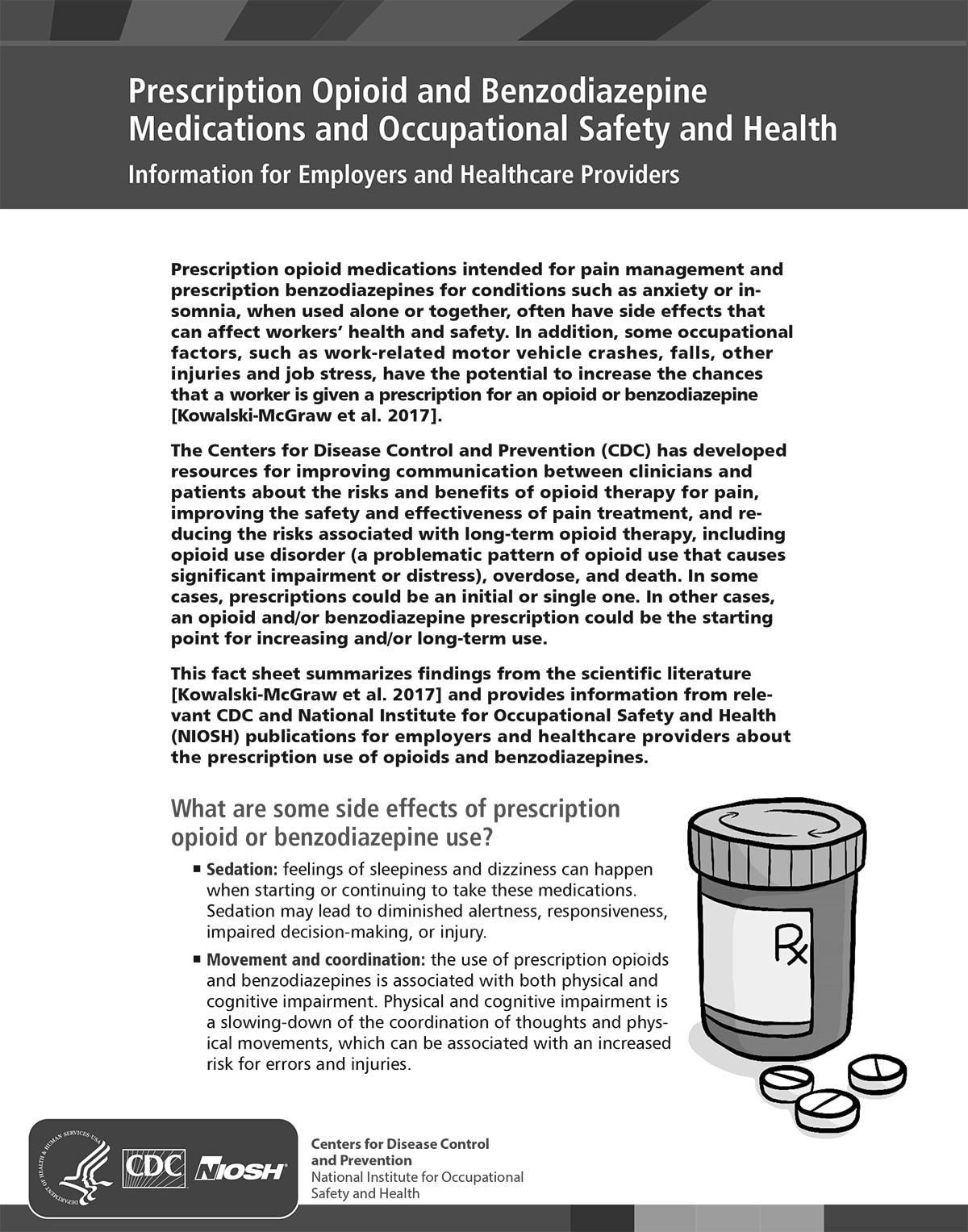
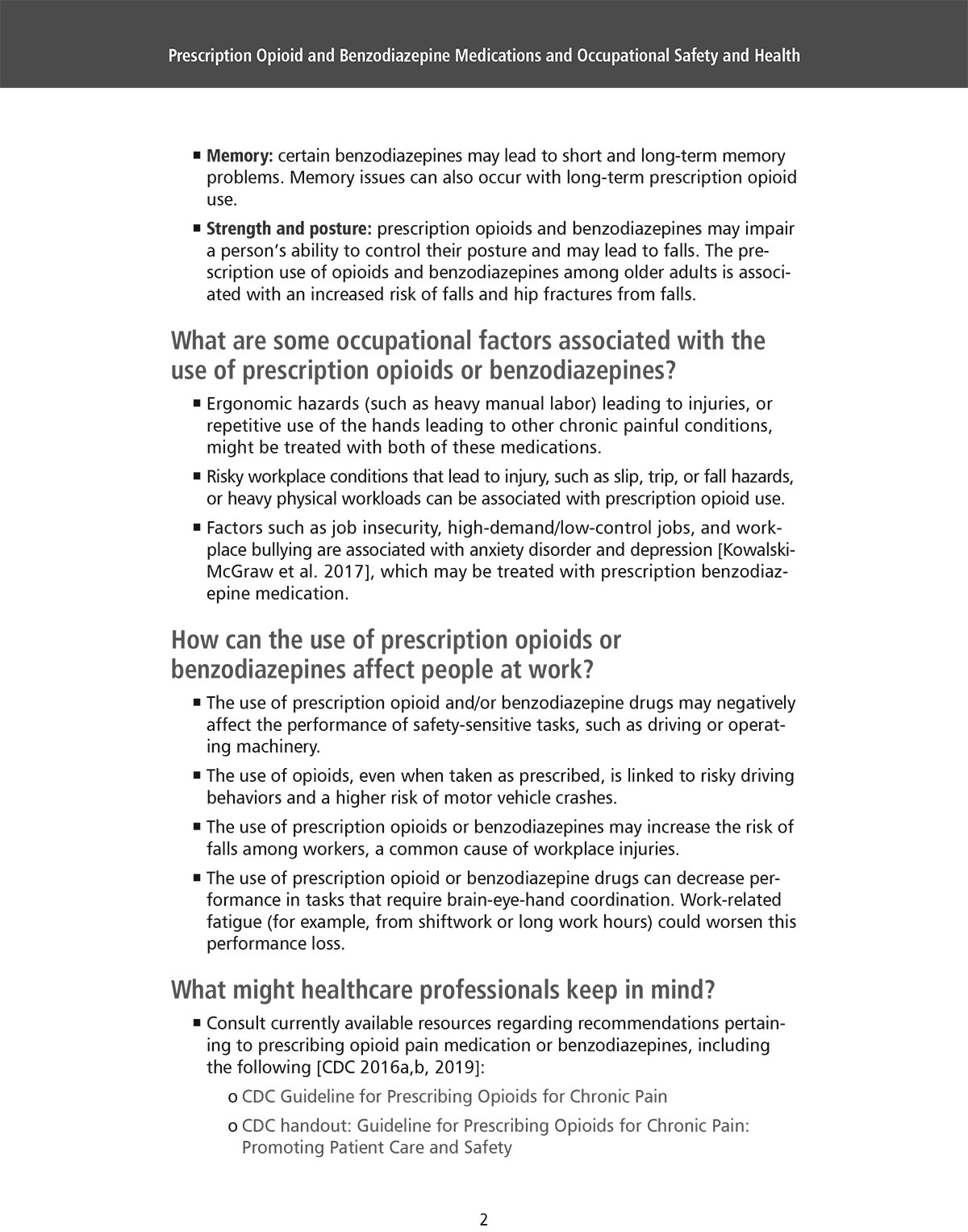
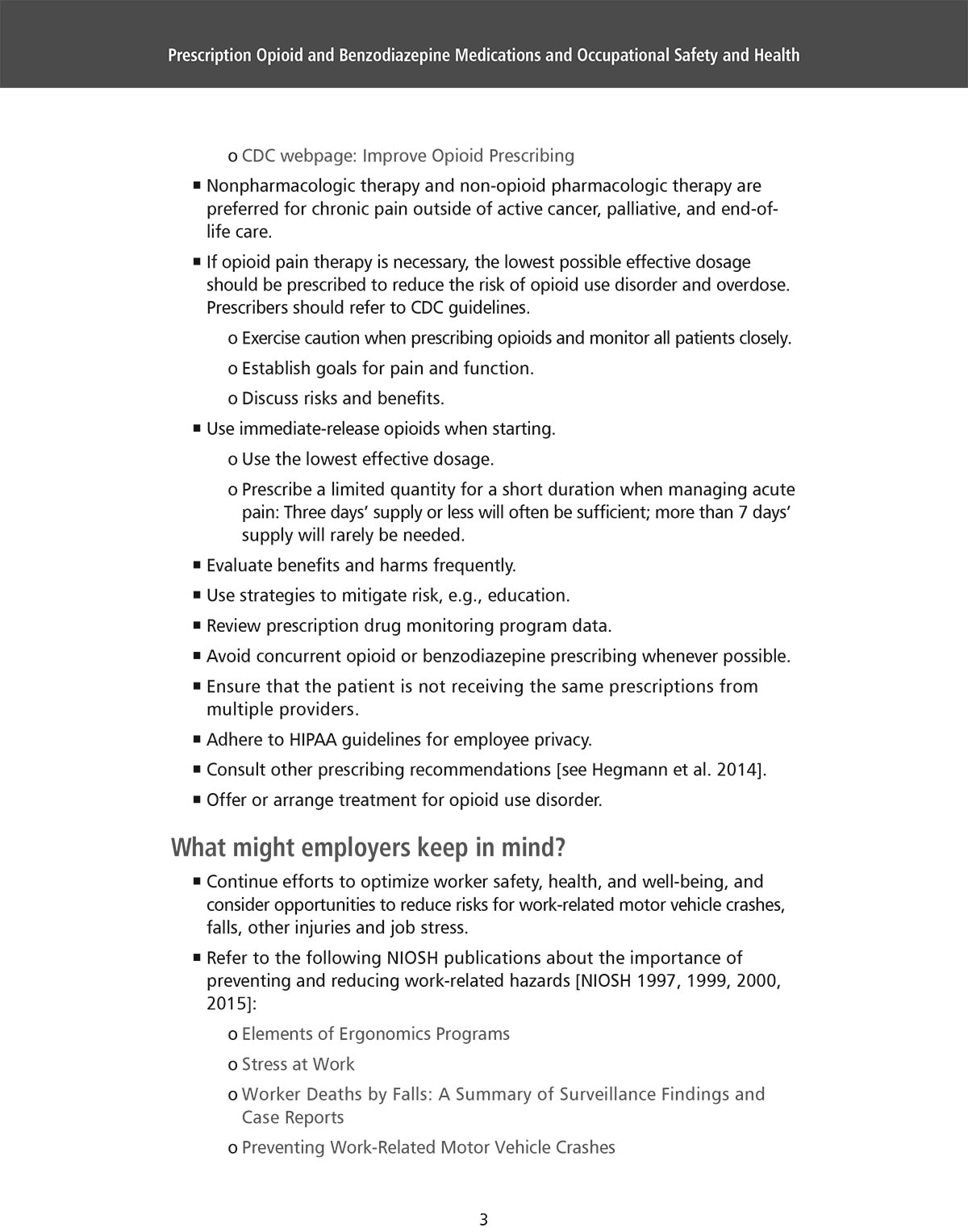
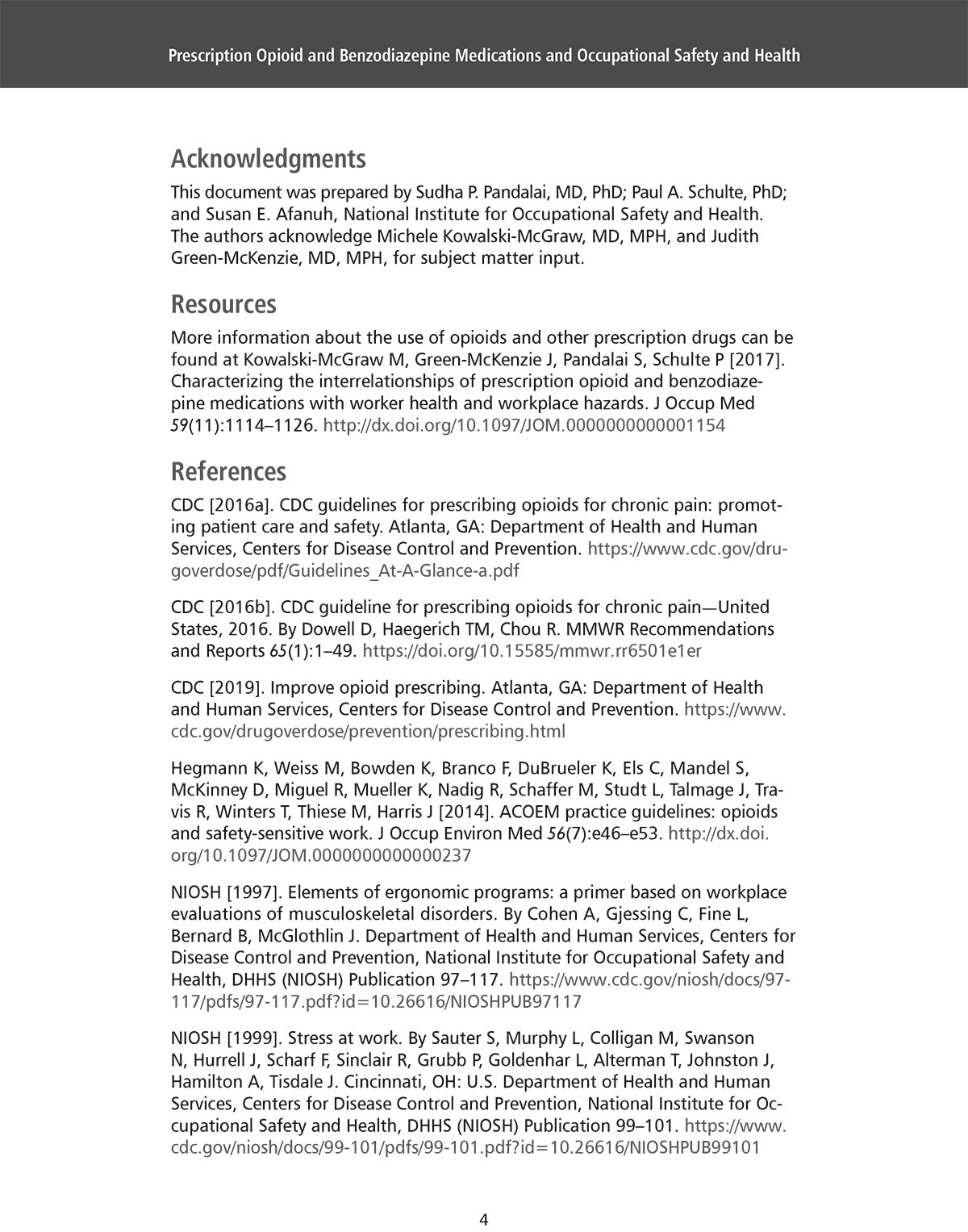
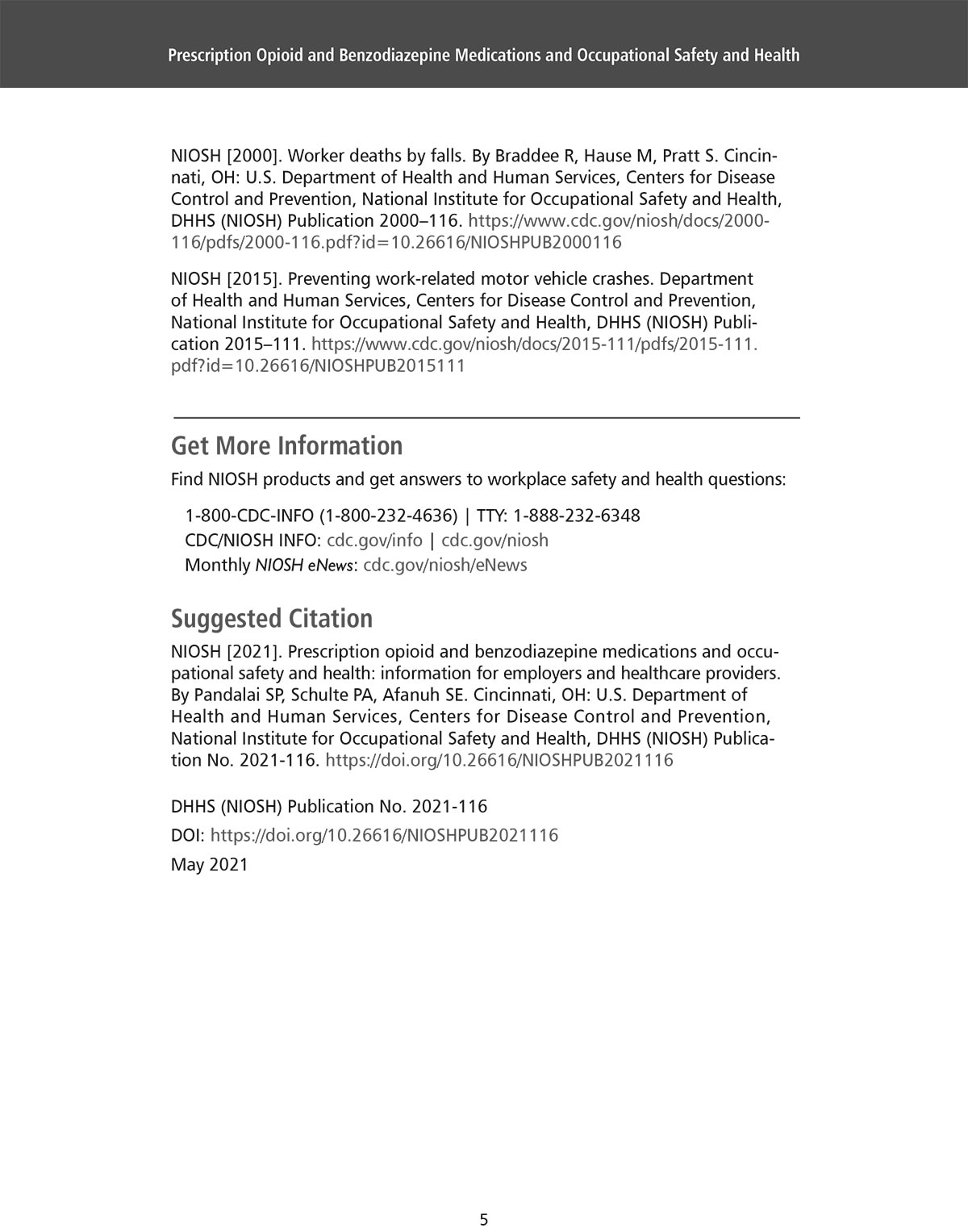
Text
Prescription Opioid and Benzodiazepine Medications and Occupational Safety and Health
Information for Employers and Providers
Prescription opioid medications intended for pain management and prescription benzodiazepines for conditions such as anxiety or insomnia, when used alone or together, often have side effects that can affect workers' health and safety. In addition, some occupational factors, such as work-related motor vehicle crashes, falls, other injuries and job stress, have the potential to increase the chances that a worker is given a prescription for an opioid or benzodiazepine [Kowalski-McGraw et al. 2017].
The Centers for Disease Control and Prevention (CDC) has developed resources for improving communication between clinicians and patients about the risks and benefits of opioid therapy for pain, improving the safety and effectiveness of pain treatment, and reducing the risks associated with long-term opioid therapy, including opioid use disorder (a problematic pattern of opioid use that causes significant impairment or distress), overdose, and death. In some cases, prescriptions could be an initial or single one. In other cases, an opioid and/or benzodiazepine prescription could be the starting point for increasing and/or long-term use.
This fact sheet summarizes findings from the scientific literature [Kowalski-McGraw et al. 2017] and provides information from relevant CDC and National Institute for Occupational Safety and Health (NIOSH) publications for employers and healthcare providers about the prescription use of opioids and benzodiazepines.
What are some side effects of prescription opioid or benzodiazepine use?
- Sedation: feelings of sleepiness and dizziness can happen when starting or continuing to take these medications. Sedation may lead to diminished alertness, responsiveness, impaired decision-making, or injury.
- Movement and coordination: the use of prescription opioids and benzodiazepines is associated with both physical and cognitive impairment. Physical and cognitive impairment isa slowing-down of the coordination of thoughts and physical movements, which can be associated with an increased risk for errors and injuries.
Graphic: Medicine bottle with pills
Graphics: Agency logos for the Department of Health and Human Services, Centers for Disease Control and Prevention, National Institute for Occupational Safety and Health
Centers for Disease Control and Prevention
National Institute for Occupational Safety and Health
- Memory: certain benzodiazepines may lead to short and long-term memory problems. Memory issues can also occur with long-term prescription opioid use.
- Strength and posture: prescription opioids and benzodiazepines may impair a person's ability to control their posture and may lead to falls. The prescription use of opioids and benzodiazepines among older adults is associated with an increased risk of falls and hip fractures from falls.
What are some occupational factors associated with the use of prescription opioids or benzodiazepines?
- Ergonomic hazards (such as heavy manual labor) leading to injuries, or repetitive use of the hands leading to other chronic painful conditions, might be treated with both of these medications.
- Risky workplace conditions that lead to injury, such as slip, trip, or fall hazards, or heavy physical workloads can be associated with prescription opioid use.
- Factors such as job insecurity, high-demand/low-control jobs, and workplace bullying are associated with anxiety disorder and depression [Kowalski-McGraw et al. 2017], which may be treated with prescription benzodiazepine medication.
How can the use of prescription opioids or benzodiazepines affect people at work?
- The use of prescription opioid and/or benzodiazepine drugs may negatively affect the performance of safety-sensitive tasks, such as driving or operating machinery.
- The use of opioids, even when taken as prescribed, is linked to risky driving behaviors and a higher risk of motor vehicle crashes.
- The use of prescription opioids or benzodiazepines may increase the risk of falls among workers, a common cause of workplace injuries.
- The use of prescription opioid or benzodiazepine drugs can decrease performance in tasks that require brain-eye-hand coordination. Work-related fatigue (for example, from shiftwork or long work hours) could worsen this performance loss.
What might healthcare professionals keep in mind?
- Consult currently available resources regarding recommendations pertaining to prescribing opioid pain medication or benzodiazepines, including the following [CDC 2016a,b, 2019]:
- CDC Guideline for Prescribing Opioids for Chronic Pain
- CDC handout: Guideline for Prescribing Opioids for Chronic Pain: Promoting Patient Care and Safety
- CDC webpage: Improve Opioid Prescribing
- Nonpharmacologic therapy and non-opioid pharmacologic therapy are preferred for chronic pain outside of active cancer, palliative, and end-of-life care.
- If opioid pain therapy is necessary, the lowest possible effective dosage should be prescribed to reduce the risk of opioid use disorder and overdose. Prescribers should refer to CDC guidelines.
- Exercise caution when prescribing opioids and monitor all patients closely.
- Establish goals for pain and function.
- Discuss risks and benefits.
- Use immediate-release opioids when starting.
- Use the lowest effective dosage.
- Prescribe a limited quantity for a short duration when managing acute pain: Three days' supply or less will often be sufficient; more than 7 days' supply will rarely be needed.
- Evaluate benefits and harms frequently.
- Use strategies to mitigate risk, e.g., education.
- Review prescription drug monitoring program data.
- Avoid concurrent opioid or benzodiazepine prescribing whenever possible.
- Ensure that the patient is not receiving the same prescriptions from multiple providers.
- Adhere to HIPAA guidelines for employee privacy.
- Consult other prescribing recommendations [see Hegmann et al. 2014].
- Offer or arrange treatment for opioid use disorder.
What might employers keep in mind?
- Continue efforts to optimize worker safety, health, and well-being, and consider opportunities to reduce risks for work-related motor vehicle crashes, falls, other injuries and job stress.
- Refer to the following NIOSH publications about the importance of preventing and reducing work-related hazards [NIOSH 1997, 1999, 2000,2015]:
- Elements of Ergonomics Programs
- Stress at Work
- Worker Deaths by Falls: A Summary of Surveillance Findings and Case Reports
- Preventing Work-Related Motor Vehicle Crashes
Acknowledgments
This document was prepared by Sudha P. Pandalai, MD, PhD; Paul A. Schulte, PhD; and Susan E. Afanuh, National Institute for Occupational Safety and Health. The authors acknowledge Michele Kowalski-McGraw, MD, MPH, and Judith Green-McKenzie, MD, MPH, for subject matter input.
Resources
More information about the use of opioids and other prescription drugs can be found at Kowalski-McGraw M, Green-McKenzie J, Pandalai S, Schulte P [2017]. Characterizing the interrelationships of prescription opioid and benzodiazepine medications with worker health and workplace hazards. J Occup Med59(11):1114–1126. http://dx.doi.org/10.1097/JOM.0000000000001154
References
CDC [2016a]. CDC guidelines for prescribing opioids for chronic pain: promoting patient care and safety. Atlanta, GA: Department of Health and Human Services, Centers for Disease Control and Prevention. https://www.cdc.gov/drugoverdose/pdf/Guidelines_At-A-Glance-a.pdf
CDC [2016b]. CDC guideline for prescribing opioids for chronic pain—United States, 2016. By Dowell D, Haegerich TM, Chou R. MMWR Recommendations and Reports 65(1):1–49. https://doi.org/10.15585/mmwr.rr6501e1er
CDC [2019]. Improve opioid prescribing. Atlanta, GA: Department of Health and Human Services, Centers for Disease Control and Prevention. https://www.cdc.gov/drugoverdose/prevention/prescribing.html
Hegmann K, Weiss M, Bowden K, Branco F, DuBrueler K, Els C, Mandel S,McKinney D, Miguel R, Mueller K, Nadig R, Schaffer M, Studt L, Talmage J, TravisR, Winters T, Thiese M, Harris J [2014]. ACOEM practice guidelines: opioidsand safety-sensitive work. J Occup Environ Med 56(7):e46–e53. http://dx.doi.org/10.1097/JOM.0000000000000237
NIOSH [1997]. Elements of ergonomic programs: a primer based on workplace evaluations of musculoskeletal disorders. By Cohen A, Gjessing C, Fine L, Bernard B, McGlothlin J. Department of Health and Human Services, Centers for Disease Control and Prevention, National Institute for Occupational Safety and Health, DHHS (NIOSH) Publication 97–117. https://www.cdc.gov/niosh/docs/97-117/pdfs/97-117.pdf?id=10.26616/NIOSHPUB97117
NIOSH [1999]. Stress at work. By Sauter S, Murphy L, Colligan M, Swanson N, Hurrell J, Scharf F, Sinclair R, Grubb P, Goldenhar L, Alterman T, Johnston J, Hamilton A, Tisdale J. Cincinnati, OH: U.S. Department of Health and Human Services, Centers for Disease Control and Prevention, National Institute for Occupational Safety and Health, DHHS (NIOSH) Publication 99–101. https://www.cdc.gov/niosh/docs/99-101/pdfs/99-101.pdf?id=10.26616/NIOSHPUB99101
NIOSH [2000]. Worker deaths by falls. By Braddee R, Hause M, Pratt S. Cincinnati, OH: U.S. Department of Health and Human Services, Centers for Disease Control and Prevention, National Institute for Occupational Safety and Health, DHHS (NIOSH) Publication 2000–116. https://www.cdc.gov/niosh/docs/2000-116/pdfs/2000-116.pdf?id=10.26616/NIOSHPUB2000116
NIOSH [2015]. Preventing work-related motor vehicle crashes. Department of Health and Human Services, Centers for Disease Control and Prevention, National Institute for Occupational Safety and Health, DHHS (NIOSH) Publication2015–111. https://www.cdc.gov/niosh/docs/2015-111/pdfs/2015-111.pdf?id=10.26616/NIOSHPUB2015111
Get More Information
Find NIOSH products and get answers to workplace safety and health questions:
1-800-CDC-INFO (1-800-232-4636) | TTY: 1-888-232-6348
CDC/NIOSH INFO: cdc.gov/info | cdc.gov/niosh
Monthly NIOSH eNews: cdc.gov/niosh/eNews
Suggested Citation
NIOSH [2021]. Prescription opioid and benzodiazepine medications and occupational safety and health: information for employers and healthcare providers. By Pandalai SP, Schulte PA, Afanuh SE. Cincinnati, OH: U.S. Department of Health and Human Services, Centers for Disease Control and Prevention, National Institute for Occupational Safety and Health, DHHS (NIOSH) Publication No. 2021-116. https://doi.org/10.26616/NIOSHPUB2021116
DHHS (NIOSH) Publication No. 2021-116
DOI: https://doi.org/10.26616/NIOSHPUB2021116
May 2021

